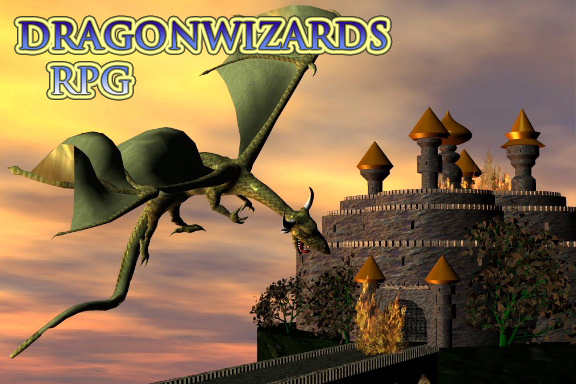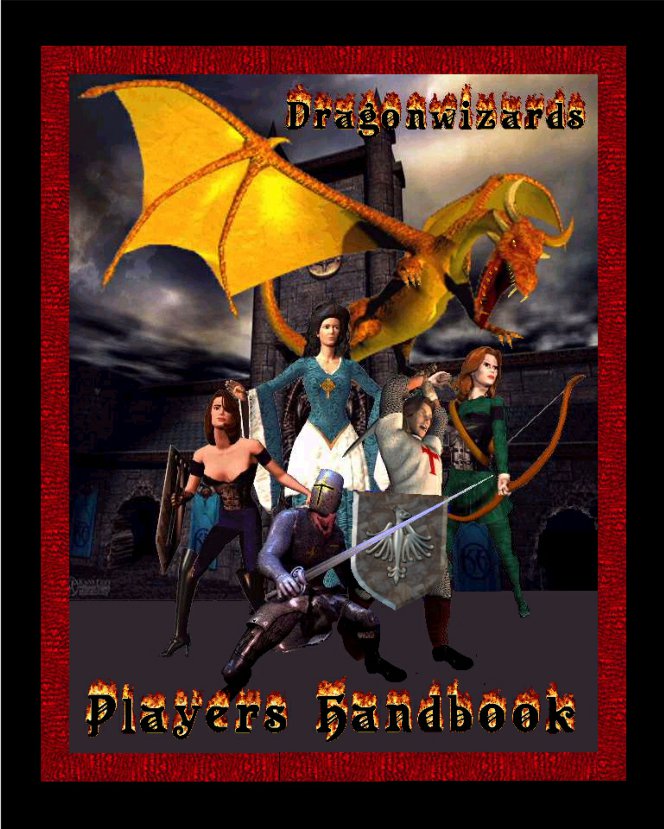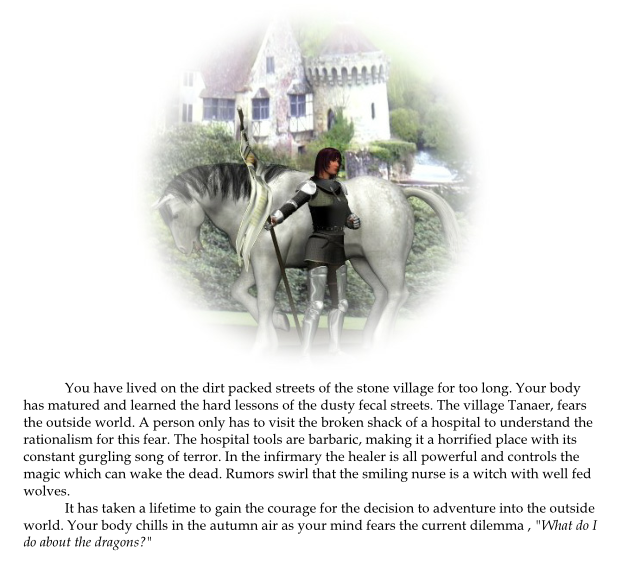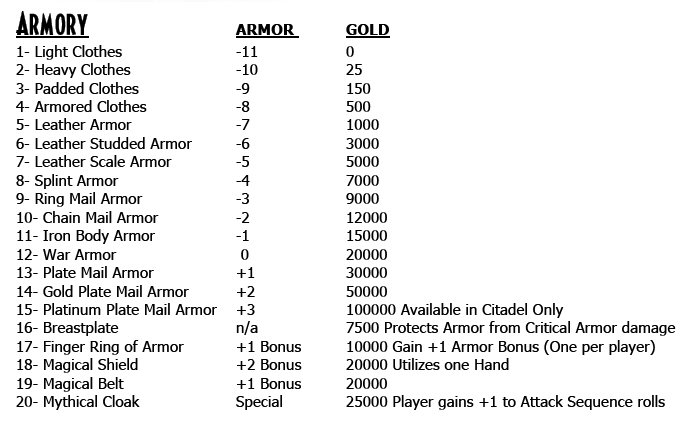Dragonwizards RPG by Rasamune
Introduction
Original SA post
So I was browsing the web looking for a free RPG to review for this thread, and guess what I found?
That's right — a tremendous piece of shit!

Dragonwizards RPG
is a free dice- and card-based dungeon-crawling game, billed as a "self-creating game system" by its creator Jason Hughes. Some of you may be familiar with Mr. Hughes' other work: at his
RPGNow store
, he sells such classic roleplaying supplements as
Fantasy Women Clipart
Vols. 1 - 10, the
Character Clipart Bargain Bin
series, and
Fantasy Girls Adult Pinup
Vols. 1-4. Apparently, for the past
ten years
, while not fiddling around in Bryce and Poser, the man has been putting together a game of his own to recreate the excitement of the dungeon-delving days of his youth.
Here, let's have him explain it to you himself:
quote:
What is this game:
I tried to discover that answer after spending 10 years creating the game system. Originally the idea was to make a self-creating game system that challenged the players to think and solve situations. After a while it became a game creation system, which used the cards to generate the movement and action. The main trouble was that suddenly I had hundreds of cards and found that the printing cost was higher than expected. So then I contemplated making it an email-turn game, and used this system to play online with 7 newbie players for a whole year. Suprisingly, they all managed to continue to the end, and subsequently I made an 8 chapter book from their adventure.
[ * The book is, in fact, available on his RPGNow store , along with a FREE download link for the Dragonwizards RPG rulebooks! The same links that are available on his site already! Shit, where's my wallet! ]
View the cards and you will realize this game became an out of control graphics adventure for myself, but even after finishing the game 5 years ago I still believe the core rules and value of plot twists, treasures, tricks and traps would especially interest a DM or GM Gamemaster. You will be impressed by the amount of ideas that this dungeon master IMAGINED to keep the players engaged and interested, even after 5 separate games...
Free player, game, weapon and monster cards are available on the links below. Also you can read the Players Guide and Gamemasters Guide so you can plan your strategy before you go into the fight. Reading tips and strategies really help players just like how reading online gaming strategies help gamblers to win their game of blackjack online [ link leads to a real online gambling site ] or other types of casino games. But the main goal is for everybody to have fun! I have always been a fan of dice, card and chips games including poker games. So I have devised a gambling system into the Dragonwizards RPG game that is simple and fun to play with. All you need is three six sided dice and you wager gold coins based on double and triple rolls. The higher the roll the more you win.
Or... try to explain, and then divert into a bizarre non sequitur and gambling site referral. Anyway!
You can download the two rulebooks, the Player's Guide and the Gamemaster's Guide , free from his website (or rather, the Mediafire page where he uploaded them. Professionalism!). Also available are the image files for the cards, that you can download free (from Picasa) and print at home! No, you can't actually buy hard copies of the cards from the vendor! Remember, printing costs!
Next time , we'll crack open the Player's Guide and dive right in to a self-creating world of ~*IMAGINATION*~
Getting Started
Original SA post Dragonwizards RPG Part 2: Getting Started
Aww yeah. Are you ready for fantasy adventure so intense that even the title of the book is on fire? Are you prepared to embark on an epic journey through badly-rendered CGI backdrops that don't even fit the cover, your expressionless Poser allies at your side? I hope you are, because we're diving right into this!
The book starts off with a page of basic information on the game. First, materials: You need the Player's Guide, the Gamemaster's Guide, the Monster Cards which are available on the website (Picasa), as well as
quote:
Role playing dice - four, six, eight, ten, twenty.
...Four, six, eight, ten, and twenty what? You and I can infer that he's talking about number of sides, of course, but the text itself doesn't say! Could be talking about different-sized groups of six-sided dice, for all a newbie would know.
Next paragraph talks about the Monster Cards, says that you can download some free from his website (Picasa) and that you can buy more on his website (no you can't) or on his CDs (not for sale).
Next come directions on printing out the game cards and character sheets, followed by mention of another option for playing the game — a shareware program that lets you randomize and display the card images from your computer, without having to print them out! Well, that sounds handy! Let's just go to his website and... oh, no, wait, no link for that either. Oh well!
This section ends with some copyright and contact information, including this little gem:
quote:
If you have received an electronic copy of this game, and have not paid for it.
Please send $5.00 to Paypal to my e-mail, with a note. *Payment for a pre-viewed copy.
I appreciate your honesty. You are welcome to share printed copies within your gaming group.
The 'electronic copy' of your game, Mr. Hughes, is available as a free download from your website (Mediafire). Bite me.
From here, we get into the actual content of the book. The introduction is a combination story/example of play, which... my god. This has to be the most atrocious prose I have ever read in an RPG rulebook. I would copy and paste passages into quote blocks to show you just how bad it is, but — did I mention that the PDF is copy-protected? No? Well, the entire PDF is copy-protected. Any text you attempt to copy from the PDF will paste into your text editor as gibberish.
...But it has no such protections again Alt+Print Screen! Hah!

...So the village fears the outside world because the hospital inside the village is a hellhole, and is also run by a necromancer and the nurse is a witch, and you're worried about the dragons and

Anyway, 'you' and your group of adventurers then set off on a voyage that had nothing to do with fucking dragons, leading you through a mountain pass, an encounter with a dangerous Sand Djinn, another mountain pass, a confusion between in-game knowledge and metagame knowledge regarding mountain "cards", a dangerous cavern full of traps and undead miners, a switch in perspective from second- to third-person, and a battle with a living monolith that ends in a near-TPK and a retreat. And in the end, our main character still wonders what he is going to do about the dragons that no one in the story has mentioned but him.
The story itself is interspersed with green parenthetical text explaining what game mechanic each part of the story refers to — drawing cards, rolling for the random encounters, trapped treasure chests, etc. Blue text denotes important game terms, and red text denotes combat results.
This is the closest we ever get to a "how to play" section until the last few pages of the Gamemaster's Guide .
Seriously. There is no chapter that shows you, step by step, with clear instructions, how to actually play the fucking game. Both rulebooks are written with the underlying assumption that you already know how the basic structure of the game works. And it's not even a traditional RPG! It's some sort of RPG-card-game hybrid, and they don't even hint at how to properly read and use the cards until the very end!
You'd think that in the ten years it supposedly took him to develop this game, the thought 'hey, maybe I should include an actual no-bullshit tutorial' would occur to him.
Anyway, the next section tells the payer how to start the game. For one player, you pick three characters out of the list in the next section; for two players, each player picks two; for three or more, each player picks only one. Each player then names his character, receives his starting gold (1000 for warrior classes, 750 for 'Scout' classes, 500 for spellcasters) and buys equipment. Next is a step called "Game Master list statistics", which I don't know what the fuck, the only explanatory text is a stat block. Then the spellcasters determine their starting spells, either by choosing manually from a list that appears later in the book or rolling randomly (why would you do this). Next, everyone determines their experience till next level by rolling a d10, and then the gamemaster draws a monster card to wait what

...Experience till next level is determined randomly? Every time you level up? And it's based on number of monsters defeated, not difficulty of monsters defeated? A piddly little kobold and a dragon would yield the same amount of experience? What the— how do you— that's not—



Anyway... the gamemaster then draws a monster card to determine who the boss of the game is going to be, so I guess it can be anything from a Death Mistress to a Buffalo . It then says to draw two monster cards per group (without explaining what a 'group' is in game terms) as Minions — also randomly, which I guess means that an Old Water Pump and the Mayor could be secretly serving as the Buffalo's left- and right-hand men. Minions apparently take damage in place of the Boss, and the Boss can't be killed until the minions are.
Then the GM is suppose to set a time limit for the dungeon after which they get teleprted to the citadel, which I guess is where the boss fight is supposed to take place but they never say that I don't know I have no idea what the fuck with this game
The game starts with the GM putting down the "Village" card, and then the players can either "attempt to complete the village area" or start the dungeon crawl. What does completing the village area entail, you ask? v
 v
v
NEXT TIME: Character classes!
Character Classes (Warriors)
Original SA post Dragonwizards RPG (yep, I'm still doing this!) Part 3: Character Classes (Warriors)Last time, we scratched our heads at the non-sequitur-riddled introduction and the game's complete failure to describe the flow of play. This time, we'll be scratching our heads at the character class selection!
The classes in Dragonwizards are divided into three groups: Warriors, Scouts, and Spellcasters. In this update, we'll be looking at the six classes that make up the Warriors.
Before we begin, let's talk about the formatting of the class descriptions. Like that of the rest of the book, it's perplexingly terrible. Combat statistics and descriptions of unique abilities are listed in the same block at the top, in no particular order, with certain abilities listed between the combat stats and others stuck at the end. Also, the descriptions for many abilities are so short and vague as to be useless — and as it turns out, the full descriptions for some of these abilities are in the description paragraph at the bottom of the page, mixed in with the flavor text . As a designer, how do you decide that this is a reasonable, readable way to present important game information?!
Now I must give credit where it's due: For as much as this game has cribbed from D&D, it does not have silly legacy mechanics like alignments, ability scores, and hit dice!
Instead, it has complete and utter nonsense!

Anyway, here are the Warriors and their powers, as well as I could understand them in this mess:

The Fighter is the hard-hitting, no-bullshit (okay, reduced bullshit) melee class. He gets a beefy 10 Lifepoints (hit points to us normal folk) per level, he has the highest natural bonus to weapon damage at +4, and he gets an additional +1 to damage per level! He can equip any weapon and armor, and as long as he has a shield equipped, he can use it to block all incoming fire from ranged weapons. He has an ability called Drain , which lets him 'withstand the loss of one ability point' — but this game doesn't have ability points, so I guess monsters can just directly drain your damage bonuses and to-hit? Hard to say if that's what they meant or if the game just left out rules for ability scores; the full description certainly doesn't clarify. He also has Mental Strength , which lets him convert any gained ability points to strength points — again, no clarification on what they meant. Also, the short description says that "All gained points become +1 Strength", not that they can be converted to +1 Strength. Odd.
The Swordsman gains 8 LP per level and has a +2 to weapon damage — unless he's wielding a sword, in which case he gets an additional +4! He can deflect incoming attacks on 1 in 6, and is incidentally immune to all diseases! He also has an ability called Mental Pain , which lets him 'block a previous hit, with a future hit' — I haven't the slightest clue what this means, and the full description just says the same thing with slightly different words. Also, their flavor text contains this masterwork of prose:

The Knight is a defensive class, I suppose? He gets 8 LP/level and +3 to weapon damage, and on account of being a knight, he gets -1 to Armor... so I guess this system works on descending AC, just like AD&D Second Edition? Let's just look at the armor listing to be sure...

Nope, ascending. So the defensive class's intrinsic ability makes his armor worse.

Anyway, the Knight, being literate and junk, also has the ability to read scrolls. And just as a side bonus, he's also immune to all poisoning! He also learns a first-level healer spell at 4th level, and learns another one each level after that... but I just looked ahead at the spell listing, and guess what? Spells aren't divided into levels! So what's with this 'first-level spell' junk? Heck if I know — book sure doesn't say!
Lastly, he gets the ability Veterinary , which lets him capture and train animals — a skill granted to him by 'anthropology', apparently.
 Also, the book naturally does not provide any mechanics on training animals.
Also, the book naturally does not provide any mechanics on training animals.
The Ranger gets 9 LP/level, +3 to weapon damage. He gets the Swordsman's parry ability, the Fighter's resistance to ability drain, and he learns one druid spell per level starting with 4th. He also has an ability that lets him heal 1 LP per day of travel — so I guess the other classes don't heal while traveling? Ah well, sucks to be them!
 Their class description also says they can craft weapons, but naturally doesn't tell you how to do that.
Their class description also says they can craft weapons, but naturally doesn't tell you how to do that.
The Gladiator gets 8 LP/level, +2 to weapon damage. He can automatically counter-attack any attack against him, and he can remain up and swinging until he hits -10 LP! He's the only class that can wield a two-handed weapon and a shield at the same time, and he also has an ability called Performance , which lets him "Beg 500 gold from crowd or building".
So like... any building? Like, can the Gladiator waltz into a library or a hospital, start swinging his mace around and hollering about splitting the skulls of his foes, and expect to get showered in gold? I certainly hope so; that would almost be enough to forgive the fact that this game is a clusterfuck.
The Monk gets 10 LP/level, and instead of getting a bonus to weapon damage, he gets "2 punches for 4 damage each", plus another 2 damage per level. He can't wield bladed weapons, and like the Knight he gets -1 to armor (despite the fact that the class description says that he gets calluses that provide natural armor — am I missing something here?), but he also can never be paralyzed or stunned. He also has the ability to go Berserk , which causes him to "flee one re-enforcement per round" — I have no idea what this means. He also has what I guess is a results chart for hand-to-hand combat? It looks like if you roll 18, you reduce the opponent's armor by 1 (I knew lower armor was bad!); 19 and you score a critical hit for +1 damage; and on a roll of 20 you crush the enemy's head and kill him outright. I guess this is determined by your to-hit roll? I don't know what the fuck with this game
Next time: Spellcasters!